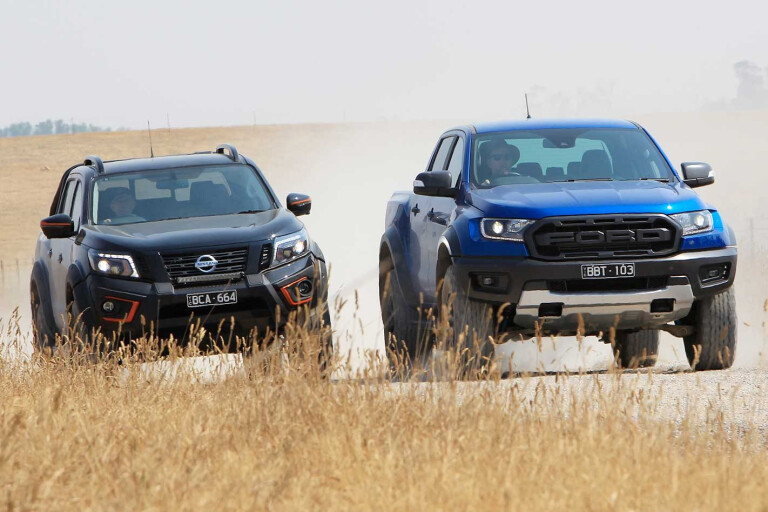
GIVEN the high development costs and relatively niche sales, Ford may not have made much money out of the Ranger Raptor. But it doesn’t matter.
What counts is that the Raptor proves that Ford knows how to get things ‘right’, and its engineering excellence not only brings praise to the Raptor itself but brings kudos to other Ranger models and Ford in general. Every car company wants a ‘hero’ model like the Raptor, to build a reputation and image around.
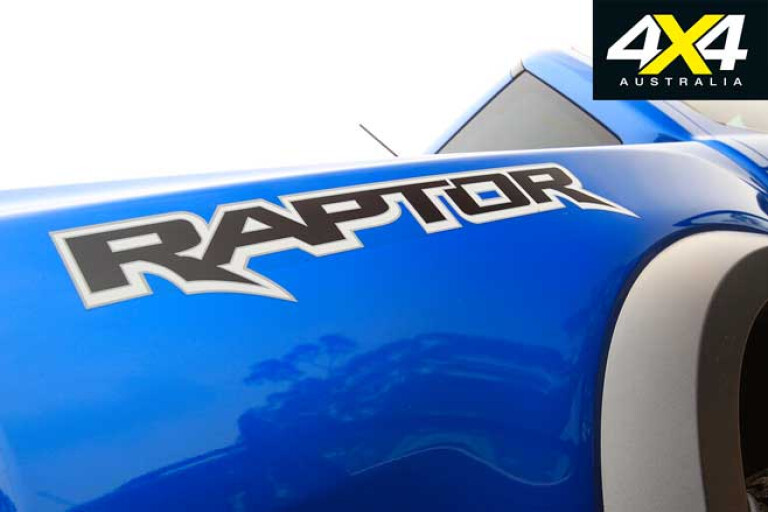
For its part Nissan needs anything it can to help the Navara’s image, let alone sales, which lag well behind the class leaders. For every Navara 4x4 that’s sold, three and a half Ranger and Hilux 4x4s drive out the showroom door. Given the previous generation D40 Navara was second only to the Hilux in sales in its day, Nissan couldn’t be happy.
Hence the Navara N-TREK Warrior. It’s Nissan’s new hero in the ring, beefed up and sent back into the fight with a comprehensive re-engineering of the suspension, a more off-road-focused wheel and tyre package, and a whole new look thanks largely to the bespoke bar and lights.
The general philosophy behind the Warrior mirrors that of the Raptor in as much as it aims primarily to improve the off-road performance while not compromising – and hopefully even improving – on-road dynamics.
Ford Ranger Raptor
Far more than a lift kit and a new wheel and tyre package, the Raptor brings race-bred chassis engineering.
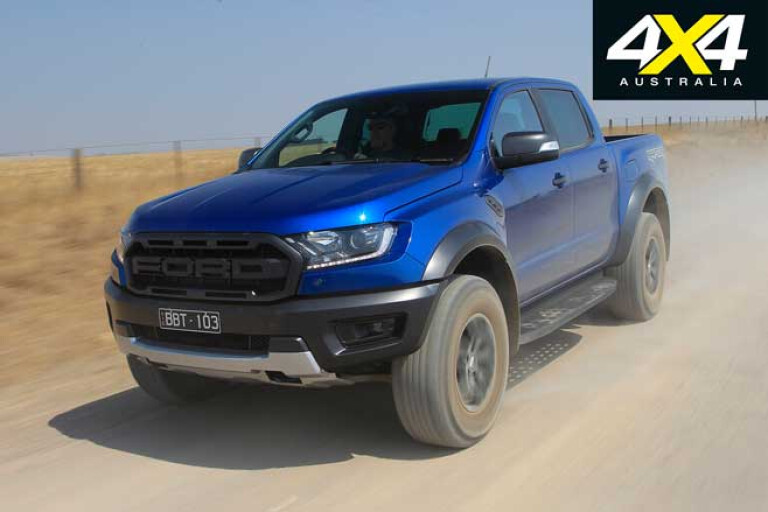
FORD Australia came up with the idea of the Raptor off the back of the success in the USA of the F150 Raptor, a desert-racing-inspired custom version of Ford’s very popular F150 pick-up.
Ford Performance, Ford’s global high-performance division, then got involved with Ford Australia to help create the Raptor. The Raptor debuted in late 2018 and went on to win our 4X4 Of The Year … comfortably.
Powertrain & Performance

THE Raptor may be crying out for a stonking petrol V8 – and may soon get one – and some people would have liked to have seen the Ranger’s grunty and endearing 3.2-litre five-cylinder diesel under the Raptor’s bonnet, but that’s not what it has.
Instead, it has the same 2.0-litre four-cylinder bi-turbo diesel and ten-speed automatic that’s offered in the XLT and Wildtrak models, the only difference from the standard Ranger drivetrain is a lower final-drive ratio to compensate for the Raptor’s taller wheel and tyre package.
Still, there’s nothing wrong with this ‘little’ 2.0-litre diesel, which is notably refined and smooth, especially in comparison to the harsher and noisier engine in the Warrior. Thanks to its sophisticated sequential bi-turbo arrangement the Raptor’s engine is also nicely flexible, with all 500Nm of torque available from just 1750rpm. Peak power (157kW) doesn’t arrive until 3750rpm.
On wider throttle openings and especially on full throttle it has a deep, throaty voice and sounds like a much bigger capacity diesel. At the same time it also spins through the revs quickly, as you’d expect of a small engine, helped by the close ratios of its 10-speed automatic, which does its job largely undetected.
Only occasionally on sudden, wider throttle openings will it produce the odd rough shift and indecisiveness in picking what gear it wants. Pedal to the metal, the Raptor has the edge on the Warrior.
On-road ride and handling

THE Raptor’s trump card isn’t its engine, though; its chassis is what makes the whole package work so well. Despite primarily aiming to make the Raptor better off-road than a stock Ranger, the quality of the re-engineering is such that the on-road dynamics, especially the ride quality and handling, is also much improved.
You can put this down to the extra suspension travel, some 30 per cent all ’round, which means suspension that soaks up the bumps beautifully. The Raptor can literally make a bumpy road feel like a smooth road.
While the Raptor retains a live axle at the rear, coils springs replace the Ranger’s leaf springs, and bespoke Fox-brand racing-tech dampers (the rears have ‘piggy-back’ reservoirs) are used all ’round. Longer A-arms up front and a different axle housing at the rear widen the stance (by 150mm) to compensate roll-stability-wise for extra ride height.

The rear axle is also laterally located by a sophisticated Watt’s link, a far superior arrangement in terms of chassis control (no bump steer) compared to the commonly used, simple and cheap to make – but dynamically flawed – Panhard rod, as used on the Warrior.
The Raptor also gets disc brakes at the rear, replacing the standard drums, another tick in its favour.
Off-road
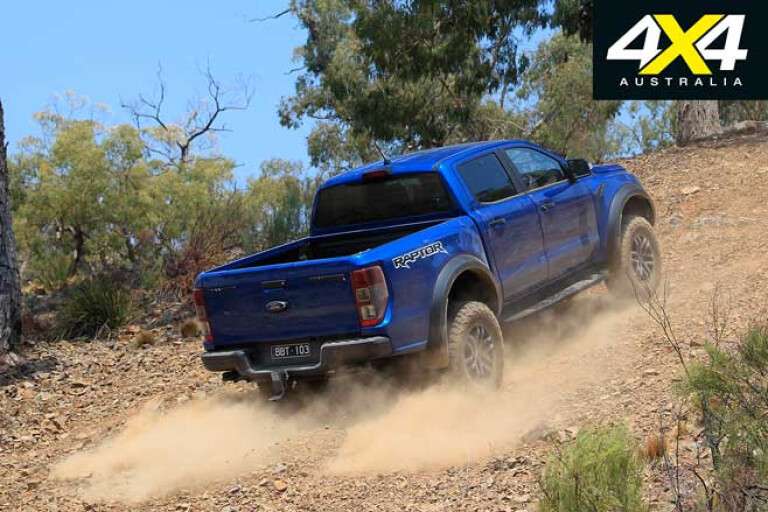
THE Raptor’s compliant, extra-long-travel suspension, loftier ground clearance and slightly taller and wider tyres also set it aside from the less off-road-capable Warrior. Not that the Warrior isn’t handy off-road, but it’s no Raptor.
The Raptor retains the Ranger’s part-time 4x4 system but has a Terrain Management’ system to fine-tune the powertrain and chassis for different driving environments. The settings run to ‘Normal’, ‘Sport’, ‘Grass/Gravel/Snow’, ‘Mud/Sand’, ‘Baja’, and ‘Rock’. All modes bar ‘Rock’ are available in high range, while all modes bar ‘Sport’ and ‘Grass/Gravel/Snow’ are available in low range.
These different modes vary the engine throttle mapping, gearbox shift protocols and the electronic traction and stability control calibration. This is a sophistication the Warrior lacks.

The Raptor comes with paddle shifters for ‘manual’ gear selection, which is handy off-road and again something the Warrior lacks.
The Raptor also claims an impressive 850mm wading depth, considerably more than the Warrior despite the fact the engine’s air intake is under the bonnet lip. Four heavy duty and easily accessible recovery hooks are also a nice touch, compared to the Warrior’s single front hook.
Compared to the Warrior the Raptor feels big off-road, essentially because it is big, and in tight spots it’s not as handy as the physically smaller Warrior.
Cabin, Accommodation and Safety

THE Raptor has a spacious and notably long cabin, just like any Ranger, and is bigger in every dimension than the more compact Warrior.
There’s still no reach adjustment for the steering wheel, but the Raptor’s heated, bespoke-leather front seats are more comfortable than the Warrior’s and the back seat also offers more space and comfort, especially for taller people and for more than two occupants.
The Raptor’s cabin wins on presentation and has the feel of a more expensive vehicle than the Warrior, which it is. With automatic emergency braking, the Raptor also leads the two in safety kit; although, it doesn’t get a driver’s knee airbag as does the Warrior.
Practicalities
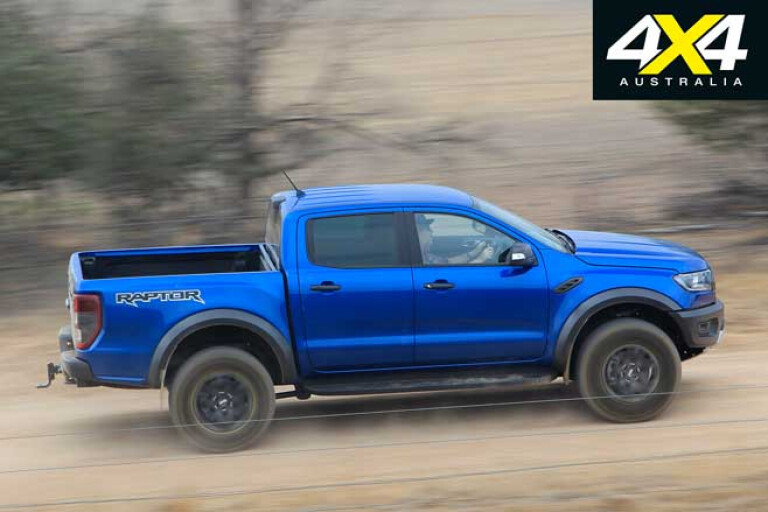
COMPARED to a standard leaf-sprung Ranger, the Raptor has less payload (758kg before you even add a driver or passengers) and less towing capacity, (reduced from 3500kg to 2500kg) which is all due to the softer, long-travel suspension. The Raptor still has a bigger tray, with a work light and better placed, but not adjustable, tie-downs.
What You Get
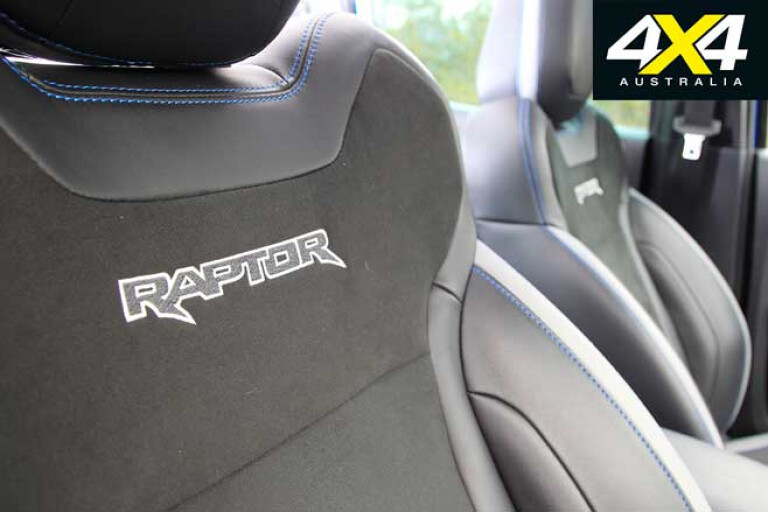
STANDARD kit on the Raptor starts with smart-key entry and push-button start, while the leather and suede-trimmed seats have eight-way power adjustment and heating up front. From there the equipment runs to auto headlights, auto high beam, rain-sensing wipers, an eight-inch touchscreen, twin USB ports, embedded sat-nav, Apple CarPlay and Android Auto, a reversing camera, dual-zone climate, a cooled centre console, paddle shifters, and a six-speaker audio complete with a CD player.
The safety kit is led by autonomous emergency braking, lane departure warning and assist, traffic sign recognition (tells you what speed zone you are in) and six airbags (front, side and curtain). The rear tub has a 12-volt outlet, a liner and a work light.
Nissan Navara N-Trek Warrior
Take one Nissan Navara and add some savvy local engineering, and you end up the N-Trek Warrior.
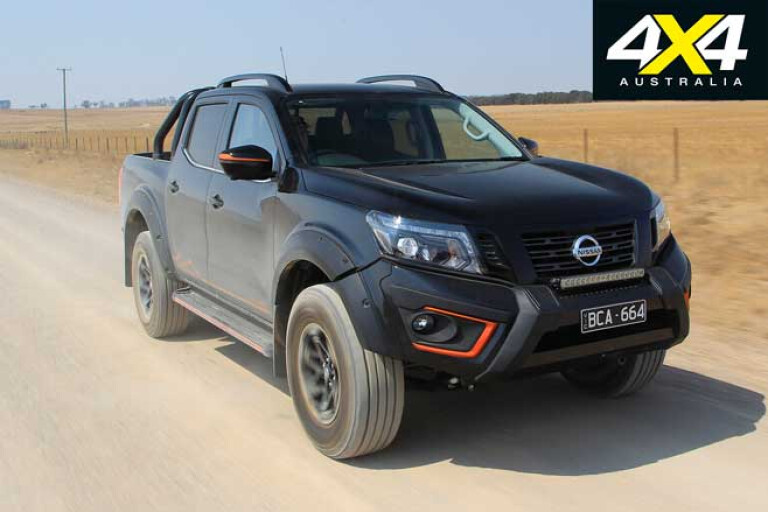
NO DOUBT inspired by the likes of the Ford Raptor and the HSV SportsCat, Nissan Australia decided that to get more cut-through with its not particularly well-loved and somewhat controversial Navara a ‘halo’ or ‘hero’ model was in order.
To this end Nissan Australia turned to Premcar, the current embodiment of Prodrive, Tickford and Ford Performance Vehicles. Premcar’s work brings specially tuned springs and dampers and a bigger wheel/tyre package, essentially to improve off-road performance.
To complete the package and to make the Warrior ready to roll from showroom to the bush, Premcar added a bespoke steel bullbar, underbody protection and siderails, as well an LED light bar, a redesigned towbar and various styling enhancements.
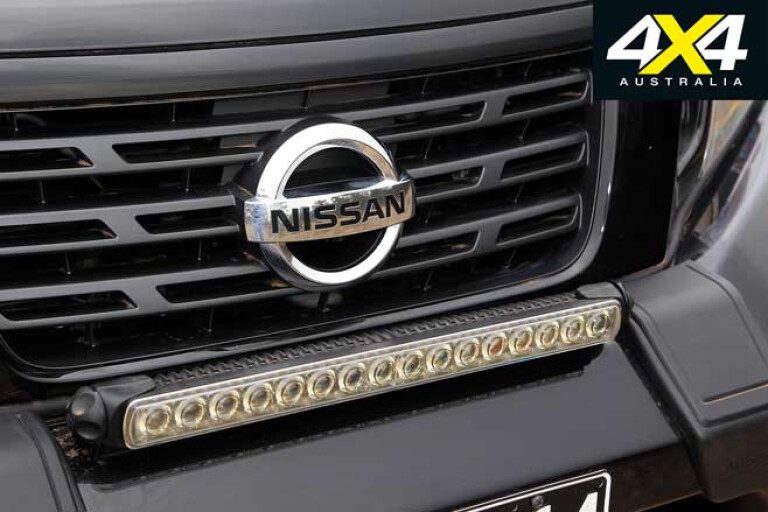
As a fully certified second-stage manufacturer, Premcar will build the Warrior in its Melbourne factory while Nissan will sell it with full factory backing and warranty via its dealer network.
The Warrior comes with standard Navara powertrain, which means it’s offered with a six-speed manual as well as a seven-speed automatic, an option the Raptor doesn’t bring to the table.
Powertrain and Performance

THE familiar Renault-sourced 2.3-litre bi-turbo four-cylinder diesel in the Warrior has a bit more work to do than it does in a standard Navara. First up there’s the Warrior’s extra hardware that adds some 200kg, while the taller tyres raise the overall gearing a little over seven per cent.
Still, this is a keen engine, as it is in a standard Navara, and while it’s a little muted in the Warrior it still continues to offer decent performance. In standard trim the Navara’s overall gearing is relatively short, so the taller tyres don’t really hurt as much as they would on something that’s already tall-geared. That’s why Ford lowered the Raptor’s final drive from that of a stock Ranger.
In typical bi-turbo style, the Warrior combines good off-idle response with its maximum torque (450Nm), on tap at just 1500rpm, with a keenness to rev as the peak power (140kW) doesn’t arrive until 3750rpm. Asked to give its all it’s still not as strong as the Raptor, but it isn’t really disgraced – driven in isolation it never really feels wanting. Compared to the Raptor, the more noticeable difference is that the Warrior is relatively noisy and harsh, especially under load.
Our road-test Warrior came with the seven-speed automatic, which shifts smoothly enough but can be reluctant to back-shift under load, preferring to generally hang on to a taller gear rather than reach for a shorter gear. It’s not as slick-shifting as the 10-speed in the Raptor, but it isn’t as indecisive as the Raptor’s ’box, just a bit on the lazy side.
On-road ride and handling

PREMCAR’S main aim with the Warrior was to improve the stock Navara’s off-road performance, but the retuned suspension works wonders on-road despite the theoretical negative of the more off-road-orientated wheel and tyre package.
The Navara is unusual among the popular utes in as much as it has coil springs rather than leaf springs at the rear. With the Warrior, dual-rate coil springs continue to be employed, but the Warrior’s (Monroe brand) springs are softer in the initial spring (34 vs 37N/mm) but firmer in the second spring (85 vs 77N/mm) than the standard items.
Up front, lighter 74N/mm springs replace the stock 79N/mm springs, but there’s an extra-long progressive bump stop which firms up the spring rate towards full compression. Quality Tenneco dampers expertly tuned by Premcar’s engineers replace the stock dampers, while the standard swaybars are retained.
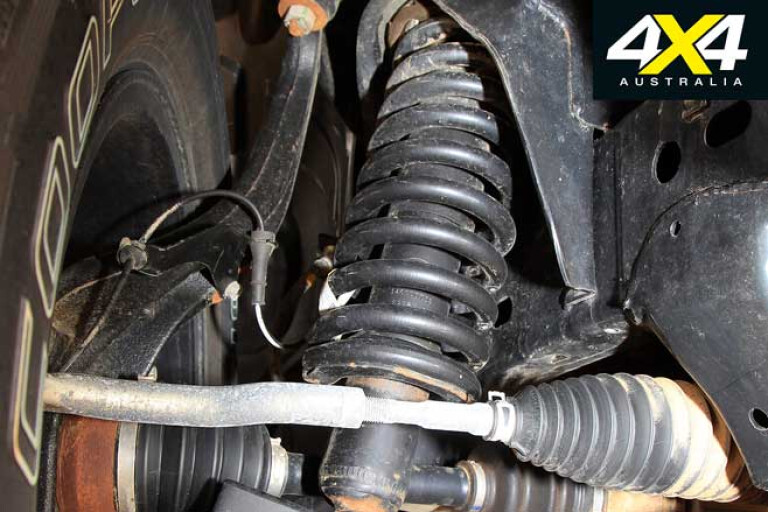
The Warrior’s ride feels firm at lower speeds, most likely due to stronger compression damping and despite the lighter initial springs, but the whole package comes together very nicely at speed and feels settled and reassuring even on bumpy, poor quality rural roads. This is a ‘Navara D23’ like you have never felt before.
The fact that the Warrior feels better on the road despite the extra ride height and light-truck all-terrain tyres is proof of the quality of Premcar’s work. Nissan has tried to get the standard Navara’s suspension right, not once, not twice, but three times, and the Warrior is still far better.
Off-road
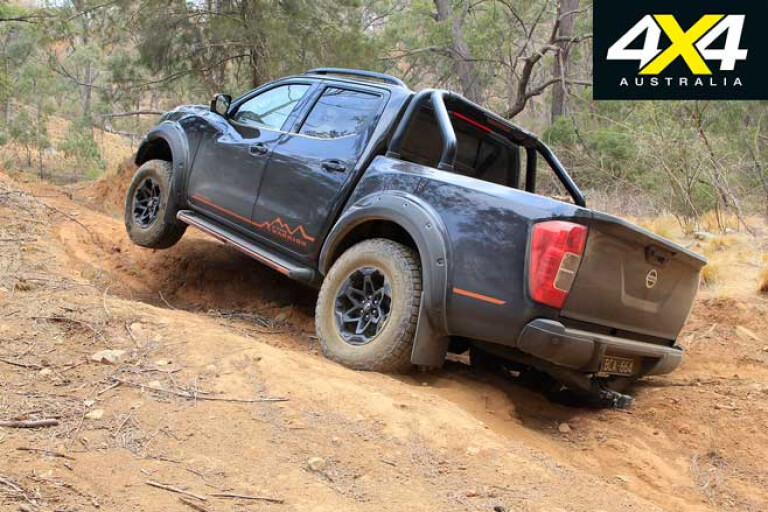
PREMCAR’S chassis changes have brought 40mm more lift, 25mm of that via the taller 275/70R17 wheel and tyre package, both of which transform the Warrior’s off-road performance from the rather modest level achieved by the standard Navara.
The Warrior has the same the rotary-dial-operated part-time 4x4 system of the standard Navara, which offers deep low-range reduction. The gearbox isn’t entirely happy in low range as it can be reluctant to downshift on descent, even when used in the ‘manual’ tip-shift mode.
Like the Raptor, the Warrior has a driver-switched rear locker, which when engaged keeps the electronic traction control active on the front axle. This is handy as you need the Warrior’s locker more often than the Raptor, as it gets by on suspension travel alone. With its shorter travel suspension, the Warrior also lacks the Raptor’s off-road comfort.
The Warrior has a shallower fording depth, despite the engine-air intake via the inner guard, but does come with a bespoke bullbar which brings some off-road toughness the Raptor doesn’t enjoy. However, there’s only one front recovery hook and none at the rear.
Cabin, Accommodation and Safety
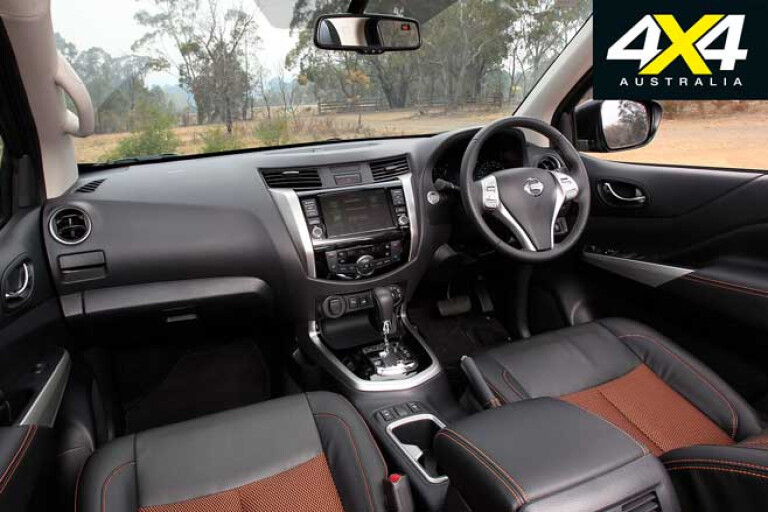
THE Warrior’s cabin isn’t as spacious up front or in the rear seat as the Raptor, and the front seats aren’t as comfortable as the excellent Raptor seats.
The Warrior is based on the top-spec ST-X Navara, which means a generous equipment list. Plus it gets its own themed interior with bespoke part-leather seat trim and carpets.
The Warrior hasn’t been ANCAP tested as such, but a standard Navara achieved a five-star rating when last tested; although, it doesn’t have any high-end safety features such as the automatic emergency braking of the Raptor.
Practicalities
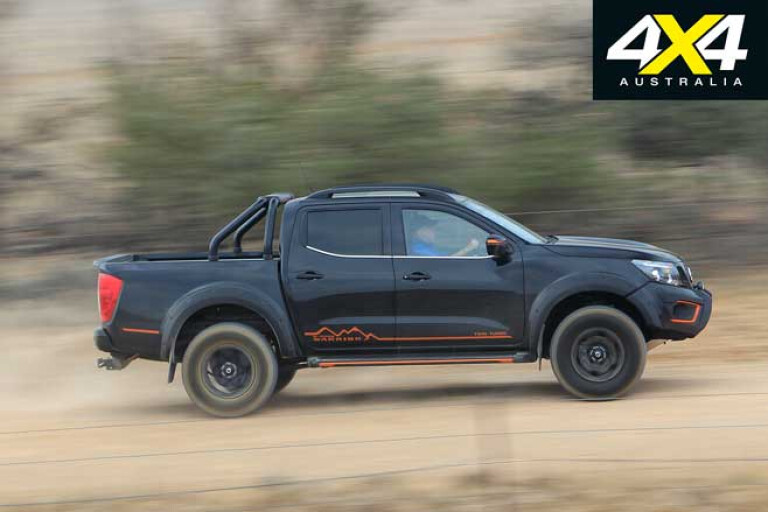
THE Warrior retains the Navara’s 3500kg towing capacity and feels like it may do a better job, chassis-wise, than a standard Navara at towing that amount; although, something around 3000kg is probably more around the mark.
Still, that’s better than the Raptor’s 2500kg limit. Truth be told, if you’re after a heavy-duty tow tug then it’s best to bypass both of these utes. Like the Raptor, the Warrior also has a modest payload rating, and while it’s good that the tie-downs in the tub are adjustable, they need to be located much lower.
What You Get

THE Warrior’s safety equipment starts with front, side, curtain and driver’s knee airbags and runs to the full suite of electronic chassis control systems, a reversing camera and a 360-degree view monitor.
Convenience and comfort features include smart-key entry, push-button start, bespoke leather seat trim, electric seat adjust for the driver and heated front seats, auto headlights, rear sliding window panel and dual-zone climate control. Embedded sat-nav, an eight-inch touchscreen and Apple CarPlay and Andriod Auto are also standard features. The rear tub has a twin-rail adjustable tie-down system and a 12-volt outlet.
The Winner - Ford Ranger Raptor

IF YOU only even want to drive a manual then there’s only one choice here, and that’s the Warrior as the Raptor is auto only. End of that story.
Then there’s the issue of budget, as there’s a significant difference here. The Raptor is $76,290 before you pay for the on-road costs, so more like $83K on the road. And that’s before you add a bullbar or lights, both standard on the Warrior.
As an automatic, the Warrior is $65,490 driveaway. The manual Warrior is $2500 less again. So, you can either buy the Warrior or spend around one-third more again to get a Raptor.
Is the Raptor a one-third better drive? Yes, that value is in there. In building the Raptor, Ford started with a better ute in the Ranger than Premcar did with the Navara, and then Ford did more work to the Ranger than has been done in creating the Warrior from the Navara.

Where Premcar’s engineers have worked within the basic suspension architecture of the Navara, Ford has made fundamental suspension changes. Thanks largely to the Raptor’s suspension it is a better drive than the Warrior on the road and more capable off it. The more refined and punchier powertrain, and extra safety kit sweetens the deal.
For all that the Warrior is still not disgraced in the Raptor's company and still feels good to drive, even jumping from one to the other. Premcar has really done a stellar job on the suspension and wheel/tyre package to make the Warrior so much better than a stock Navara, both on and off the road. Premcar’s effort even puts the Navara-based Mercedes X-Class to shame.
So while there’s value on the Raptor, there’s also plenty of value in the Warrior.
Specifications

| Ford Ranger Raptor | Nissan Navara N-Trek Warrior | |
| Engine | 2.0-litre 4-cyl bi-turbo-diesel | 2.3-litre 4-cyl bi-turbo diesel |
| Power | 157kW @ 3750rpm | 140kW @ 3750rpm |
| Torque | 500Nm @ 1750-2000rpm | 450Nm @ 1500-2500rpm |
| Gearbox | 10-speed automatic | 7-speed automatic |
| 4x4 System | Dual-range part-time | |
| Crawl Ratio | 47.6:1 | 44.4:1 |
| Construction | Separate-chassis | |
| Suspension (f) | Independent/coil springs | Independent/coil springs |
| Suspension (r) | Live-axle/coil springs | |
| Wheel/tyre spec | LT285/70R17 116/113 S | LT275/70R17 121/118 Q |
| Departure Angle | 24.0˚ | 19.0˚ |
| Rampover Angle | 24.0˚ | 27.5˚ |
| Approach Angle | 32.5˚ | 35.0˚ |
| Wading Depth | 850mm | 500mm (approx.) |
| Ground Clearance | 283mm | 268mm |
| Kerb Weight | 2332kg | 2186kg |
| GVM | 3090kg | 2910kg |
| Payload | 758kg | 724kg |
| Towing capacity | 2500kg | 3500kg |
| GCM | 5350kg | 5910kg |
| Fuel capacity | 80 litres | 80 litres |
| ADR fuel claim | 8.2L/100km | 7.0L/100km |
| Test fuel use | 12.0L/100km | 11.6L/100km |
| Test fuel range | 617km | 640km |
| Price | $76,290 (plus ORC) | $65,490 (driveaway) |

COMMENTS